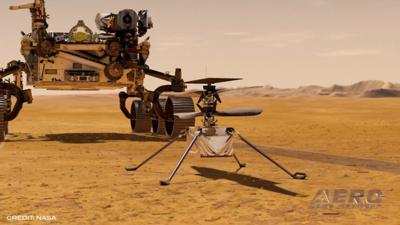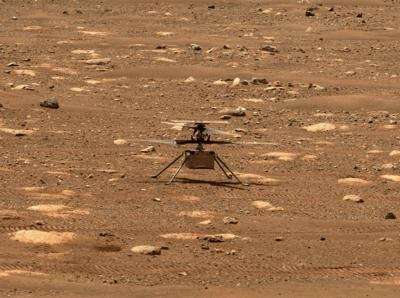Ingenuity Unlocked Its Rotor Blades, Allowing Them To Spin Freely, On 4/7
Based on data from the Ingenuity Mars helicopter that arrived late Friday night, NASA has chosen to reschedule the Ingenuity Mars Helicopter’s first experimental flight to no earlier than April 14.

During a high-speed spin test of the rotors on Friday, the command sequence controlling the test ended early due to a “watchdog” timer expiration. This occurred as it was trying to transition the flight computer from ‘Pre-Flight’ to ‘Flight’ mode. The helicopter is safe and healthy and communicated its full telemetry set to Earth.
The watchdog timer oversees the command sequence and alerts the system to any potential issues. It helps the system stay safe by not proceeding if an issue is observed and worked as planned.
The helicopter team is reviewing telemetry to diagnose and understand the issue. Following that, they will reschedule the full-speed test.
While the Ingenuity team has been focusing on getting ready for its first flight on Mars, the team has also been busy selecting a time for that flight. A number of factors go into this important decision.
First, Ingenuity cannot fly at night. It depends on its camera to observe the ground while navigating, and that wouldn't be possible at night. If it weren't for that, nighttime would be a good time for a helicopter to fly on Mars. The air density would be higher, which would make flying easier.
Next, Ingenuity needs to be a good guest. It needs to coordinate all its activities with the Perseverance rover. For example, Perseverance is keeping a watchful eye on Ingenuity with the rover's cameras, and needs to know when it is planning to do certain activities. There are also times when Perseverance is busy with transmitting on the radio to relay satellites overhead, or managing the many science instruments on the rover, or performing other spacecraft operations.

When Ingenuity is flying, it uses a lot of power-many hundreds of watts. The lithium-ion battery that powers Ingenuity's two main propulsion and six blade pitch control motors needs to handle power surges as Ingenuity flies and fights any winds and gusts it may encounter. The helicopter's voltage needs to be maintained so that motors do not stall or electronic devices get in trouble. Ingenuity comes out of the cold Martian night without much energy in its battery, so it needs to bask in the Sun to warm up and let the solar panel charge up the battery enough to handle the power demands of the day. All this means that Ingenuity cannot fly too early in the morning. Midday and afternoon are far better.
Flight can't happen too late in the Martian day either. A long flight late in the afternoon could deplete the battery without giving the Sun a chance to recharge it.
Another consideration is the expected winds at flight time. Ingenuity has been tested in simulated winds, using computer models as well as a big "wind-wall" the team built in one of the test chambers at JPL. However, they can't test over the entire range of wind conditions that one might experience on Mars. The biggest risk is at takeoff and landing, when an untimely gust could present challenges. To help with this, they have a "weather forecast" team that provides them with the best estimate of Martian winds using computer models and initial data from weather sensors on the Perseverance rover.
The Ingenuity operations team is considering all of these factors in the selection of the best flight time. The uplink team bakes these times into the sequences that get uploaded in the days leading up to first flight.
 ANN's Daily Aero-Term (04.24.24): Runway Lead-in Light System
ANN's Daily Aero-Term (04.24.24): Runway Lead-in Light System ANN's Daily Aero-Linx (04.24.24)
ANN's Daily Aero-Linx (04.24.24) Aero-FAQ: Dave Juwel's Aviation Marketing Stories -- ITBOA BNITBOB
Aero-FAQ: Dave Juwel's Aviation Marketing Stories -- ITBOA BNITBOB Classic Aero-TV: Best Seat in The House -- 'Inside' The AeroShell Aerobatic Team
Classic Aero-TV: Best Seat in The House -- 'Inside' The AeroShell Aerobatic Team Airborne Affordable Flyers 04.18.24: CarbonCub UL, Fisher, Affordable Flyer Expo
Airborne Affordable Flyers 04.18.24: CarbonCub UL, Fisher, Affordable Flyer Expo




